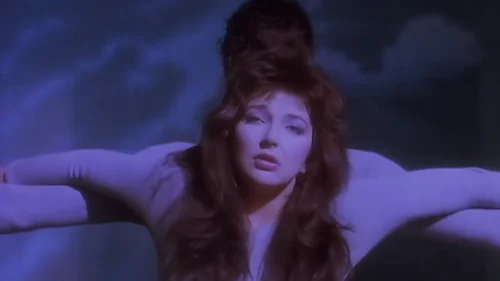In the pantheon of music legends, Kate Bush stands as a singular beacon of creativity, innovation, and artistic integrity. Bursting onto the scene in 1978 with her ethereal hit “Wuthering Heights,” Bush immediately distinguished herself from her contemporaries not just through her unique vocal range and literary-inspired lyrics, but also through her pioneering approach to music videos. At a time when the concept of music videos was still nascent, and their potential as a medium for artistic expression largely unexplored, Bush seized upon them as an extension of her storytelling, a visual counterpart to her intricate soundscapes.
Kate Bush’s career is a tapestry of bold experimentation and musical exploration. From her debut album, “The Kick Inside,” to her more recent work, she has continually pushed the boundaries of what music can be, both sonically and visually. Her artistic vision is uncompromising, marked by a willingness to explore deep emotional landscapes and complex thematic content, from the depths of human psychology to the intricacies of human relationships and the mysteries of the natural world.
Impact on Music Videos
Her distinctiveness in the music industry cannot be overstated. Unlike many artists of her time, Bush maintained full creative control over her music and videos, a rarity in an industry known for its constraints on artist autonomy. This control allowed her to craft music videos that were not mere promotional tools but art pieces in their own right, rich with symbolism, narrative depth, and visual innovation.
Bush’s innovative use of the music video medium extended her artistic expression beyond audio, turning each video into an immersive experience. Through her use of dance, costume, and narrative, she transformed music videos into a space for avant-garde theatre, creating works that were not just seen but felt, experiences that stayed with viewers long after the last note had played. Her videos, from the stark simplicity and expressive choreography of “Wuthering Heights” to the cinematic storytelling of “Cloudbusting,” showcase a breadth of creativity and a depth of emotional engagement that set new standards for what music videos could achieve.
The Beginnings: Experimentation and Identity
“Wuthering Heights”: A Visual and Musical Declaration
Kate Bush’s debut music video, “Wuthering Heights,” serves as a profound declaration of her visual and musical identity, heralding the arrival of an artist unafraid to merge dramatic performance with pop music. The video, characterized by its iconic choreography and ethereal quality, perfectly encapsulates the spirit of Emily Brontë’s gothic novel from which it draws inspiration. Bush, clad in a flowing red dress, performs an interpretative dance against a stark, misty backdrop that feels both haunting and deeply romantic. Her movements are at once precise and fluid, embodying the song’s narrative of love and longing beyond death. This choreography, combined with her ethereal vocals, sets a precedent for Bush’s career, establishing her as an artist who transcends traditional pop music constraints to create something wholly unique and enduring.
Early Music Videos Overview: From Performance to Narrative
The initial phase of Kate Bush’s career in music videos marks a period of bold experimentation and a gradual shift from performance-based videos to narrative storytelling. Following “Wuthering Heights,” Bush continued to explore the possibilities of the music video format, using it as a canvas to expand the narrative and emotional depth of her songs.
“The Man with the Child in His Eyes”
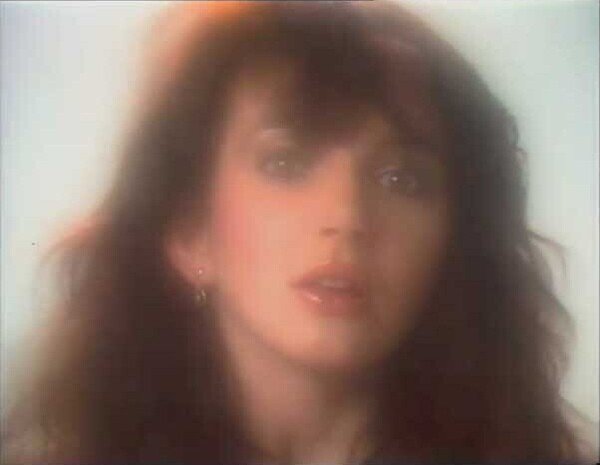
“The Man with the Child in His Eyes” offers a stark contrast to the visual complexity of her debut video. Here, the focus is on Bush’s expressive performance, captured in a simple setting that underscores the song’s introspective quality. This video highlights Bush’s ability to convey profound emotion and connection through the lens of the camera, relying on the strength of her performance rather than elaborate visuals.
“Them Heavy People”
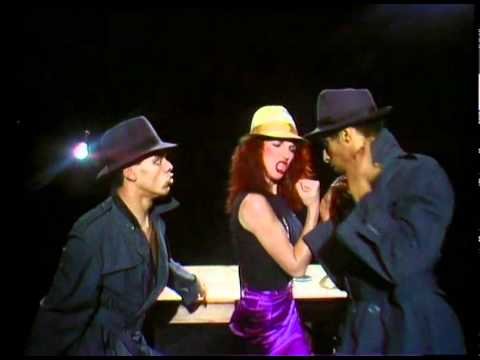
“Them Heavy People” sees Bush incorporating more theatrical elements and choreography into her videos, blending dance with a series of evocative, symbolic images. This video reflects Bush’s growing confidence in using visual metaphors to complement her unique musical style, engaging the viewer with both the lyrical depth and the visual storytelling.
“Wow”

“Wow” further showcases Bush’s evolving narrative approach, featuring a more elaborate production that satirizes the entertainment industry. “Wow” illustrates Bush’s keen interest in exploring complex themes through a mix of performance art and narrative storytelling, set within the seemingly conventional format of a pop music video.
“Hammer Horror”
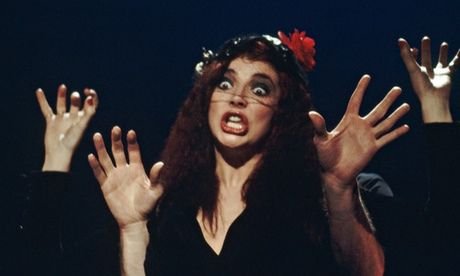
“Hammer Horror” takes Bush’s penchant for storytelling to a new level, drawing inspiration from the horror film genre to create a visually striking and thematically rich video. The video’s narrative, centered on themes of jealousy and obsession, is brought to life through Bush’s dramatic performance and the use of haunting, gothic imagery. It stands as a testament to her growing ambition and sophistication as a visual artist, further blurring the lines between music video and short film.
Through these early music videos, Kate Bush not only defined her artistic identity but also expanded the boundaries of what music videos could represent. Her transition from simple performance videos to complex narrative pieces paved the way for a career marked by continuous innovation and artistic exploration. Bush’s early videography laid the foundation for her future works, establishing her as a pioneering figure in the integration of music and visual art.
The Golden Era: Theatricality and Visual Narratives
“Babooshka”: A Dualistic Visual Symphony
The music video for “Babooshka” marks a significant moment in Kate Bush’s exploration of theatricality and visual narratives, utilizing the concept of dual characters to delve into themes of identity, trust, and the complexity of human relationships. In this visually captivating piece, Bush portrays both the youthful, seductive Babooshka and the older, neglected wife, using contrasting costumes and settings to highlight the thematic contrasts between perception and reality, illusion and truth. The dramatic use of costumes, from the chainmail bodysuit of Babooshka to the more demure attire of the wife, serves as a powerful visual metaphor for the song’s exploration of the facades people maintain in relationships. The stark juxtaposition of these characters, coupled with Bush’s emotive performance, creates a vivid narrative that enhances the song’s underlying message about the destructive power of doubt and deception.
Sociopolitical Narratives and Visual Poetry
“Army Dreamers”
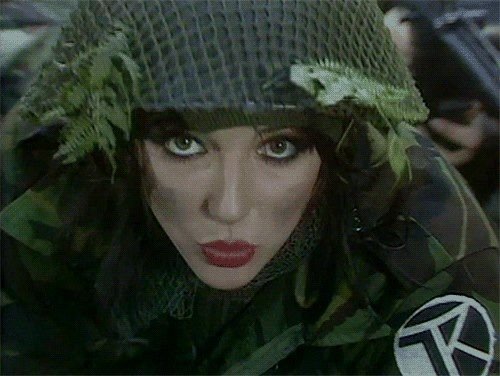
“Army Dreamers” is a poignant anti-war song, and its accompanying video reinforces this message through haunting imagery and choreography. Set against a backdrop of misty woodlands, the video depicts the tragic futility of war, with Bush’s mournful performance and the somber procession of soldiers highlighting the loss of young lives. The use of slow motion and the ethereal woodland setting creates a dreamlike quality that contrasts sharply with the stark reality of the song’s subject matter, making a powerful statement on the senselessness of war.
“Breathing”
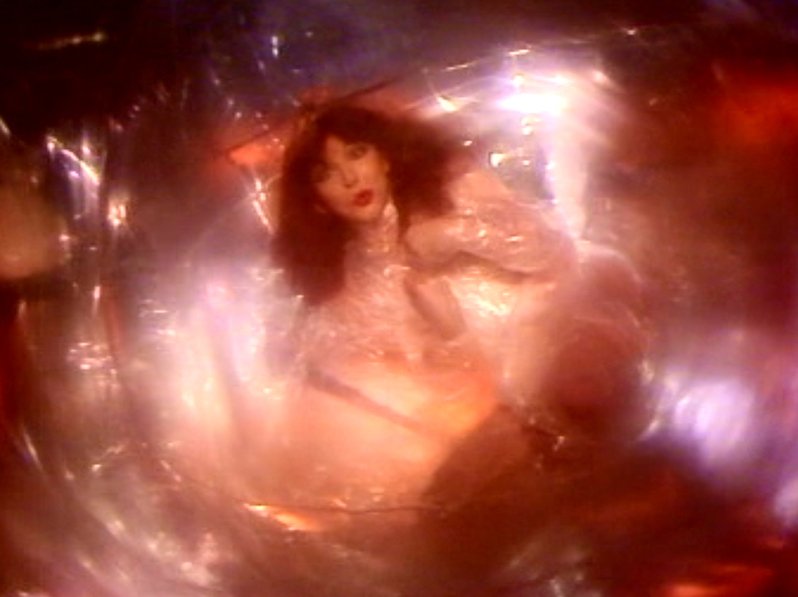
“Breathing” explores the fear of nuclear fallout, a reflection of the Cold War anxieties of its time. The video is notable for its use of surreal visuals to represent the unborn child’s perspective, breathing through the placenta, which metaphorically serves as a filter from the nuclear threat outside. This innovative use of visuals to complement the song’s message about the fragility of life and the omnipresent threat of annihilation showcases Bush’s ability to weave complex narratives through her music videos, challenging viewers to confront uncomfortable realities.
Through these videos, Kate Bush solidified her status as a pioneering artist in the golden era of music video production. Her work during this period is characterized by a fearless embrace of theatricality and visual narratives, using the medium to delve into complex themes and social commentary with depth, innovation, and emotional resonance.
The Dreaming Album: A Foray into Surrealism and Identity
The music videos from Kate Bush’s 1982 album, “The Dreaming,” mark a distinct shift towards more surreal and experimental visual narratives, reflecting the album’s exploration of identity, consciousness, and societal issues. Each video from this era—“The Dreaming,” “There Goes a Tenner,” “Sat in Your Lap,” and “Suspended in Gaffa”—showcases Bush’s deepening engagement with the visual possibilities of her music, utilizing a blend of surreal imagery, theatrical performances, and narrative depth to complement the album’s eclectic sounds and themes.
“The Dreaming”
The title track’s video, “The Dreaming,” delves into the dark history of colonialism in Australia, using a mix of animation and live-action to create a haunting visual narrative. Bush portrays a variety of characters, including a digger and a native Australian, to explore themes of exploitation and cultural destruction. The use of surreal imagery—such as animated sequences and symbolic props—enhances the song’s commentary on the erasure of indigenous cultures and the environmental impact of colonial greed. This video stands out for its bold attempt to address complex historical and social issues through the medium of a music video, blending art and advocacy in Bush’s unique style.
“There Goes a Tenner”
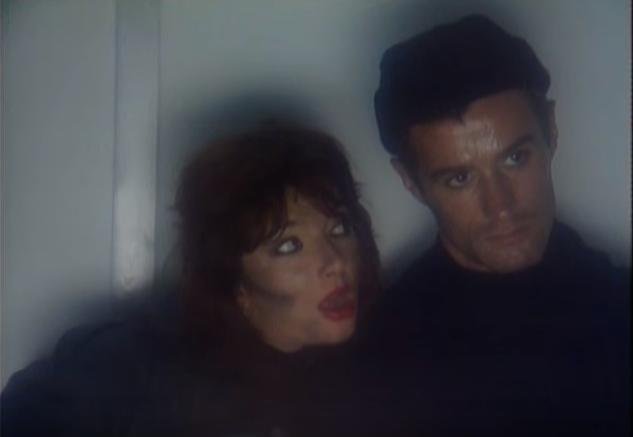
In “There Goes a Tenner,” Bush takes a lighter, more narrative-driven approach, presenting a comedic heist story. Dressed as a bank robber alongside her hapless crew, Bush embarks on a caper that is both humorous and tension-filled. The video’s cinematic style, complete with dramatic close-ups and a storyline that unfolds with a blend of suspense and farce, showcases Bush’s ability to traverse different genres and tones, highlighting her versatility as a storyteller. This piece reflects the album’s thematic exploration of dreams and reality, presenting the heist as a metaphor for the pursuit of desires and the often unexpected outcomes of our endeavors.
“Sat in Your Lap”
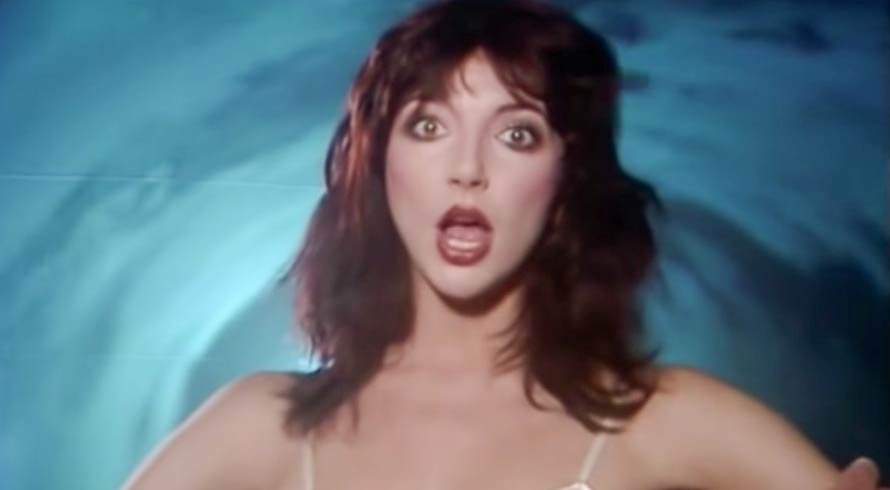
“Sat in Your Lap” features a visual feast of symbolic imagery and frenetic energy, mirroring the song’s themes of knowledge, achievement, and the overwhelming quest for enlightenment. The video is a kaleidoscope of characters and costumes, from jesters and scholars to historical figures, all swirling around Bush in a chaotic dance that represents the tumult of seeking wisdom and the burden of ambition. The use of rapid editing and vibrant, surreal costumes emphasizes the song’s message about the dizzying pursuit of understanding, making it a visually striking and thought-provoking piece.
“Suspended in Gaffa”

Lastly, “Suspended in Gaffa” presents a dream-like exploration of desire and the frustration of unattainable goals. Set in a rustic barn, Bush performs with a blend of yearning and whimsy, reflecting the song’s narrative of reaching for something just out of grasp. The video’s use of slow-motion, combined with Bush’s expressive performance, captures the feeling of being suspended between desire and reality, encapsulated in the refrain of not being able to get what you want. This video, like the others from “The Dreaming,” showcases Bush’s continued evolution as a visual artist, unafraid to explore complex themes through the lens of her unique creative vision.
The music videos from “The Dreaming” album are a testament to Kate Bush’s mastery of visual storytelling, demonstrating her ability to merge surreal imagery, narrative depth, and theatrical performance to create videos that are not only visually captivating but also rich in meaning. Through these works, Bush solidifies her reputation as an innovative artist, pushing the boundaries of the music video medium to explore the intricacies of human experience, societal issues, and the endless landscape of the imagination.
Artistic Maturation: Cinematic and Conceptual Depth
As Kate Bush’s career progressed, her music videos began to reflect a deeper cinematic and conceptual maturity, moving beyond the realm of traditional pop videos into the territory of short films. This period, marked notably by the videos from the albums “Hounds of Love” and “The Sensual World,” showcases Bush’s evolving artistry, where each video serves not just as a visual accompaniment to her music but as a standalone piece of cinematic art.
“Running Up That Hill”
“Running Up That Hill” represents a groundbreaking moment in the use of contemporary dance and visual effects in music videos to explore complex themes of human connection, struggle, and the desire for understanding between genders. The video features Bush and dancer Michael Hervieu in a powerful, interpretative dance that serves as a metaphor for the song’s exploration of making a deal with God to swap places with a loved one to understand each other better. The choreography, characterized by its intensity and emotional depth, perfectly encapsulates the song’s themes, creating a visual representation of the lyrical content that is both striking and deeply moving.
“Cloudbusting”: A Cinematic Masterpiece
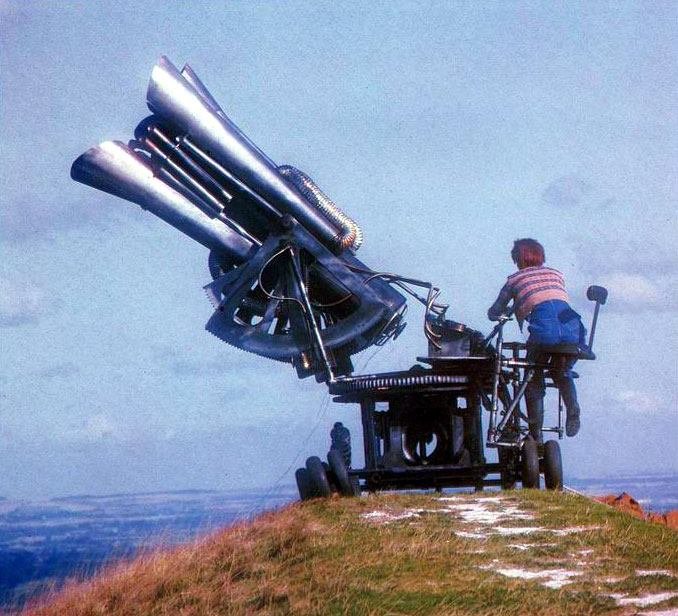
“Cloudbusting” stands out as a pinnacle of Bush’s videography, a mini-film that combines deep storytelling with historical references and emotional depth. Inspired by Peter Reich’s book “A Book of Dreams,” which recounts his relationship with his father, Wilhelm Reich, a psychoanalyst and inventor persecuted by the U.S. government, the video features Bush as Peter, reliving the memories of his father’s attempts to make it rain using the cloudbuster. Donald Sutherland stars as Wilhelm Reich, lending the video a gravitas that elevates its narrative. The video, directed by Julian Doyle, mirrors the narrative’s complexity through its rich, cinematic imagery and emotional performances, encapsulating the song’s themes of hope, loss, and the unbreakable bonds between a father and son. Its historical references and the portrayal of government oppression add layers of depth, making it a compelling narrative piece that transcends the typical music video format.
“Hounds of Love”
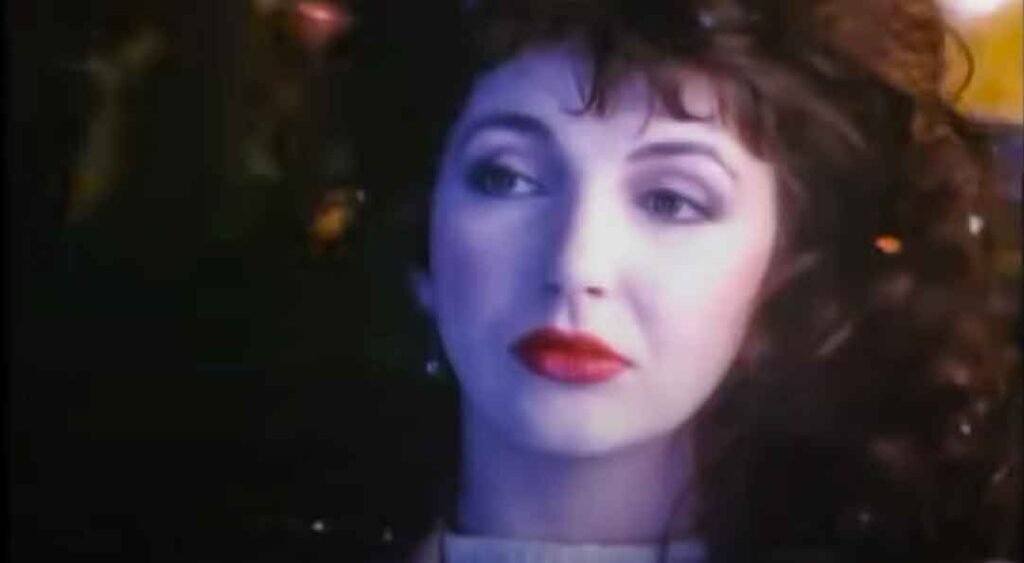
In “Hounds of Love,” Bush employs abstract imagery and narrative to evoke deep emotional landscapes, exploring themes of fear, love, and the instinctual drive for survival. The video, which alternates between scenes of Bush being pursued in a dark, foreboding atmosphere and her embrace of love and life, uses metaphor and symbolism to convey the complex emotions associated with human relationships and the desire to escape from one’s fears.
“The Big Sky”
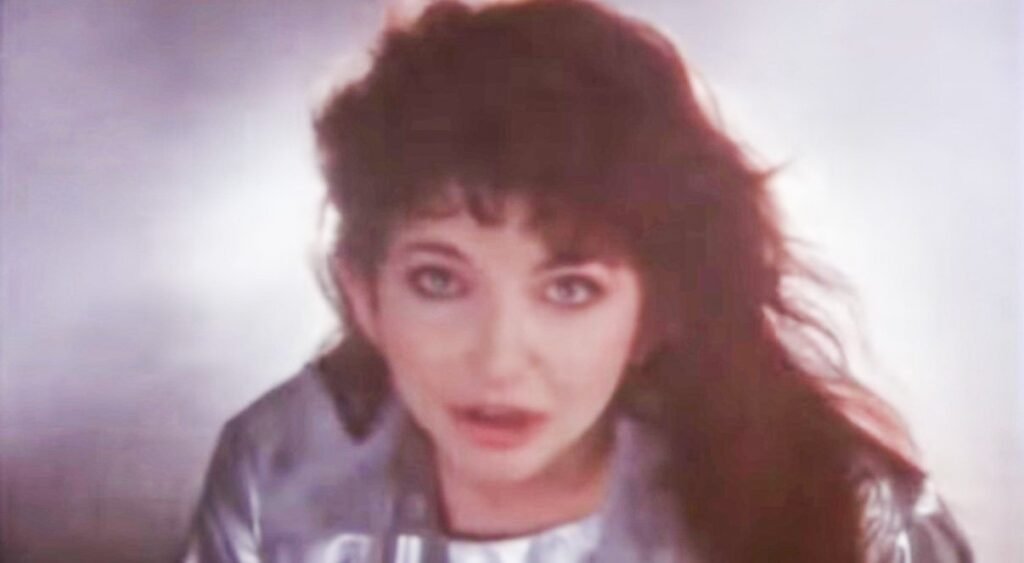
“The Big Sky” video complements its song by celebrating the vastness and beauty of the natural world, and the human emotions that such grandeur can inspire. It features Bush performing with exuberant energy against a backdrop of sky imagery, interspersed with shots of diverse people looking up in wonder. The video’s use of rapid cuts and close-ups of faces in awe reflects the song’s themes of interconnectedness and the shared human experience of marveling at the universe’s wonders.
“Experiment IV”
The video for “Experiment IV” tells the story of a secret military project aimed at creating a sound that could kill. Bush appears both as a scientist involved in the project and as the manifestation of the deadly sound wave. The narrative unfolds in a secretive laboratory setting, moving from the initial experiments to the catastrophic unleashing of the sound on unwitting soldiers. This storyline serves as a critique of military escalation and the ethical implications of scientific research when subverted for destructive purposes.
“The Sensual World”
“The Sensual World” video is a lush, visually stunning piece that captures the essence of sensual exploration and the joy of physical and emotional connection. Drawing inspiration from James Joyce’s “Ulysses,” it features Bush dancing through an enchanted forest, enveloped in rich, vibrant colors that mirror the song’s celebration of life’s physical pleasures. The video’s cinematic quality is evident in its attention to detail and the use of natural landscapes to complement the song’s themes.
“This Woman’s Work”
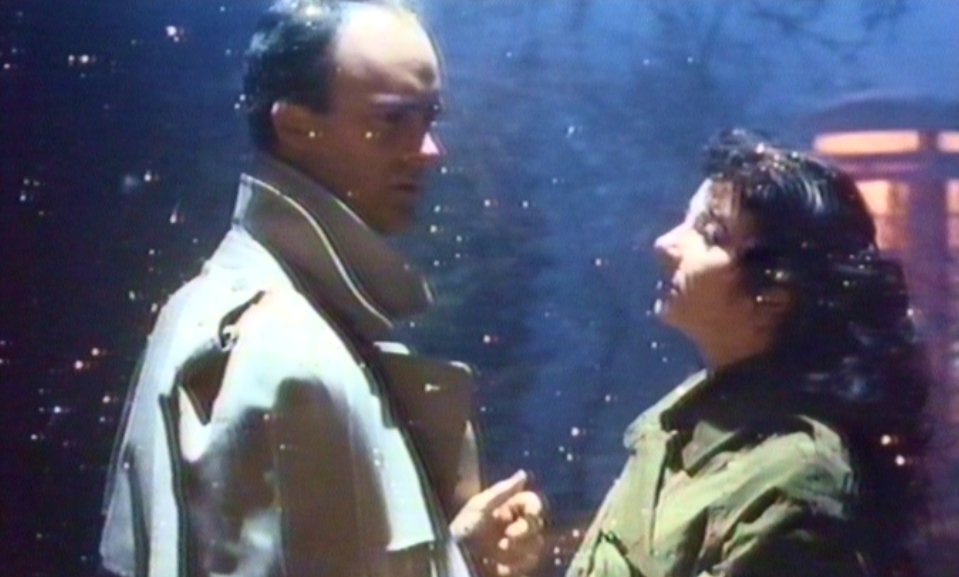
“This Woman’s Work” is one of Bush’s most poignant and introspective videos, exploring themes of vulnerability, strength, and the complexities of gender roles. The video, featuring Bush and actor Tim McInnerny, tells a story of a couple facing a crisis, interspersed with flashbacks that highlight moments of their relationship. Its minimalistic approach, focusing on emotional expressions and subtle interactions, emphasizes the song’s powerful message about the often-unseen labor and emotional support women provide.
“Love and Anger”
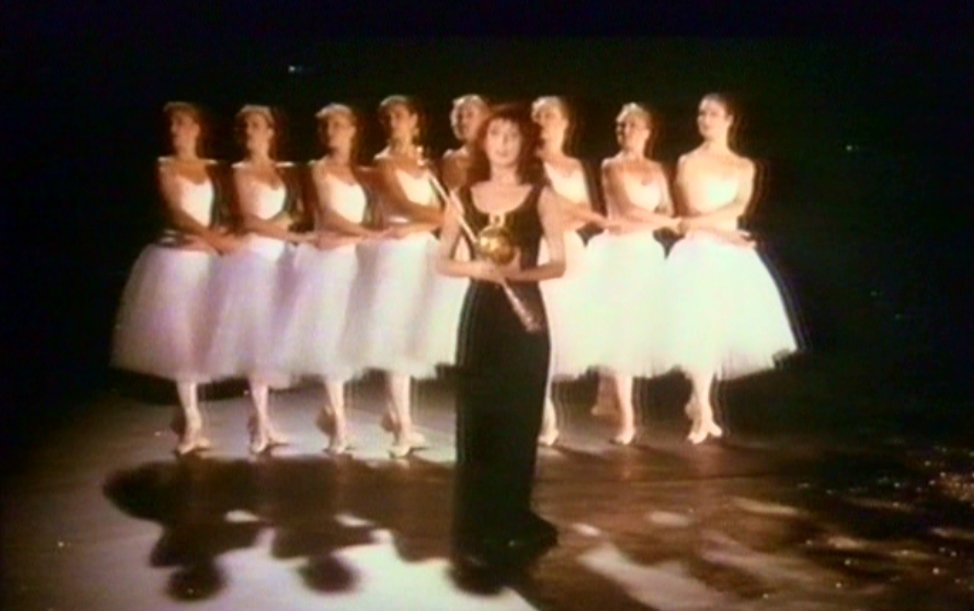
“Love and Anger” presents a visually abstract exploration of the song’s themes, featuring Bush in a series of surreal, colorful settings that represent the tumultuous nature of human emotions. The video’s use of symbolic imagery, such as the blindfolded dancers and the play with light and shadow, reflects the complexity of love and the struggles inherent in personal and creative expression.
Through these videos, Kate Bush demonstrates a profound artistic maturation, using cinematic techniques and conceptual depth to explore more introspective and universal themes. Her work during this period not only solidifies her status as a pioneer in the music video art form but also as a storyteller capable of weaving complex narratives that resonate on a deeply emotional level.
The Red Shoes Videos: From “The Line, The Cross & The Curve” to Music Video Artistry
Kate Bush’s 1993 album, “The Red Shoes,” was accompanied by an ambitious project—a short film titled “The Line, The Cross & The Curve.” This film, inspired by Michael Powell and Emeric Pressburger’s “The Red Shoes” and incorporating elements of dance, magic, and a quest for artistic integrity, served as the backdrop for several music videos from the album. These videos, extracted from the film, stand on their own as individual pieces of art, each contributing to the narrative arc of the film while also encapsulating the essence of their respective songs.
“Rubberband Girl”
The video for “Rubberband Girl” opens with Bush performing an energetic dance, embodying the song’s themes of resilience and adaptability. The choreography, characterized by its elasticity and vigor, visually represents the metaphorical ‘bouncing back’ from life’s challenges. Set against a backdrop of shifting scenes from the short film, the video captures the spirit of freedom and the joy of movement, serving as a powerful visual metaphor for the song’s message.
“And So Is Love”
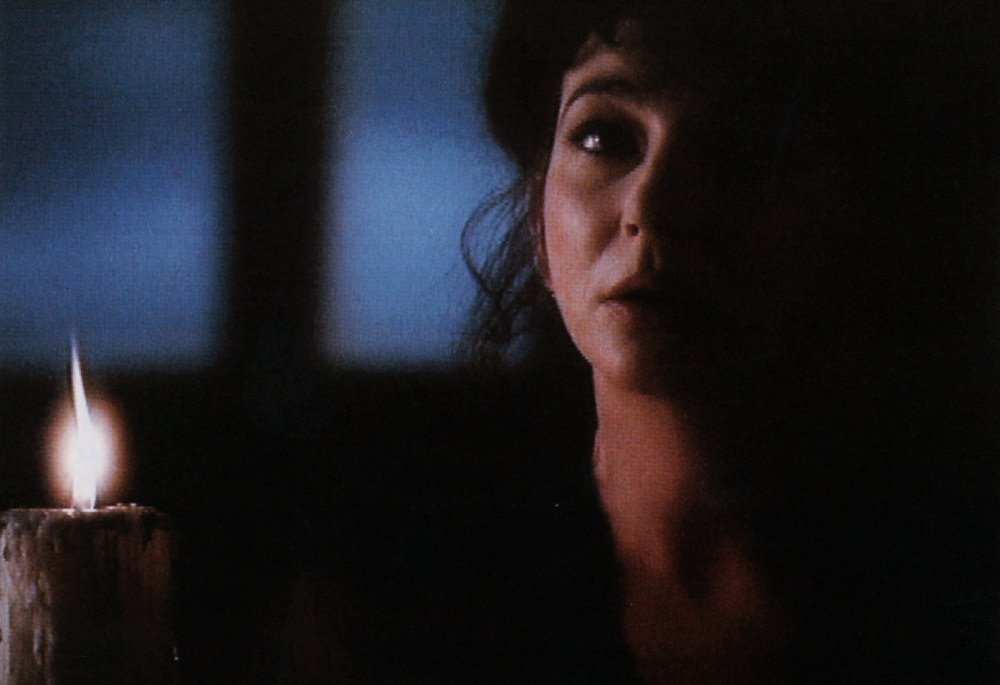
“And So Is Love” features Bush in a more reflective and subdued performance, highlighting the song’s exploration of love’s complexities and the pain of loss. The video, interspersed with scenes of artistic creation and destruction from “The Line, The Cross & The Curve,” mirrors the song’s contemplative nature. It visually represents the bittersweet acceptance of love’s impermanence, reinforced by the poignant imagery of Bush interacting with the elements of the film’s narrative.
“The Red Shoes”
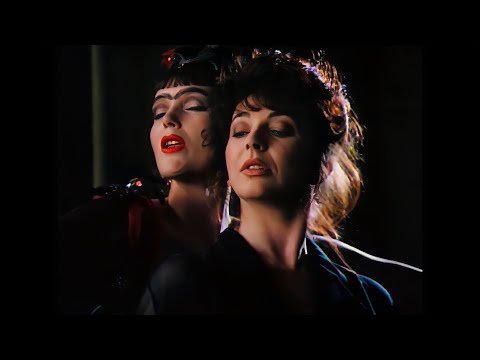
The title track’s video, “The Red Shoes,” is directly tied to the film’s central motif—the enchanted shoes that compel Bush’s character to dance uncontrollably. The video captures the frenetic energy and desperation of the dance, symbolizing the allure and dangers of creative obsession. It’s a vivid depiction of the struggle between artistic passion and the search for balance, with Bush’s performance conveying both the ecstasy and the agony of unbridled creativity.
“Lily”

In “Lily,” the video opens with the ritual invocation of protective spirits, setting a tone of mysticism and spiritual seeking. Bush’s performance, surrounded by symbols of magic and transformation, reflects the song’s themes of guidance and protection. The video’s use of ethereal visuals and symbolic imagery complements the song’s meditative quality, inviting viewers into a space of spiritual contemplation.
“Moments of Pleasure”
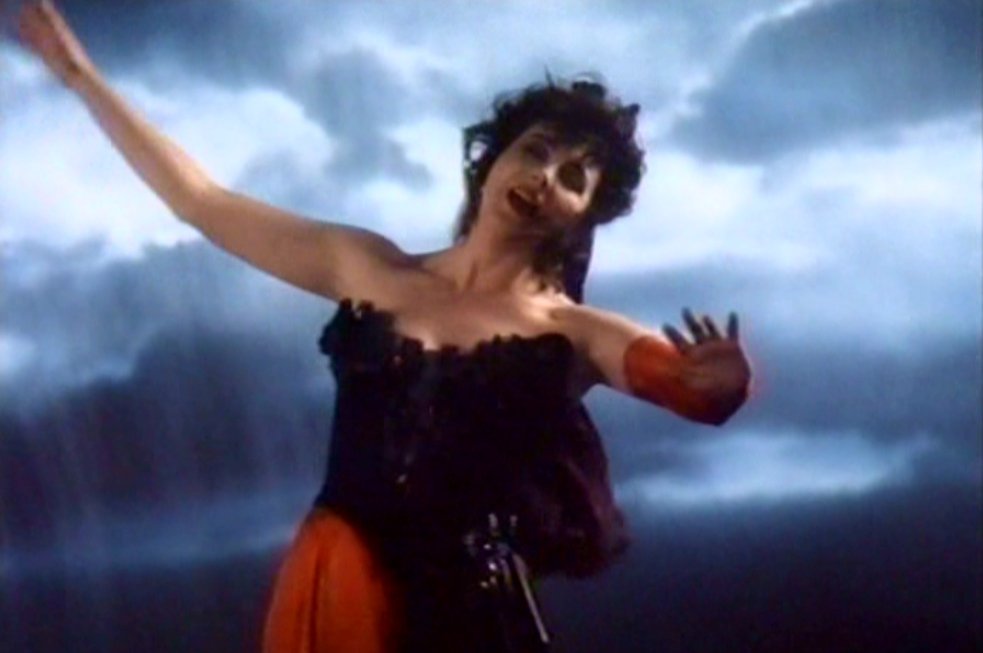
“Moments of Pleasure” is a deeply personal song, and its video is a poignant reflection on loss, memory, and the cherishing of life’s fleeting moments. The video features Bush in a series of vignettes that evoke memories of loved ones and times past, interspersed with scenes from the film that highlight the journey of self-discovery and reconciliation. The use of soft lighting and intimate close-ups enhances the song’s reflective and heartfelt message.
“Eat the Music”
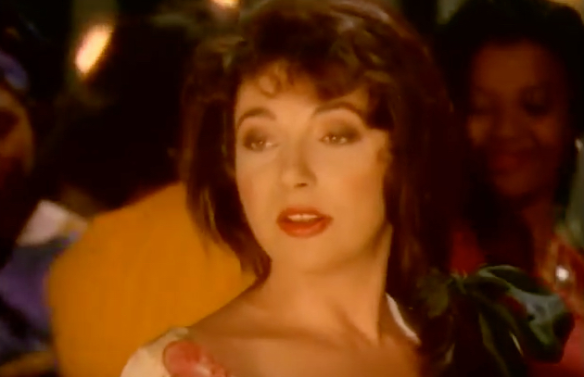
The video for “Eat the Music” is a celebration of sensuality and the vibrant life force, filled with vivid colors and exuberant performances. Bush, surrounded by a cornucopia of fruits and flowers, embraces the song’s themes of indulgence and the joy of life. The video’s lush, tropical setting and the playful interaction with the dancers and musicians reflect the song’s celebration of nature’s bounty and the sensory pleasures of existence.
Through these videos, Kate Bush not only extends the narrative and visual world of “The Line, The Cross & The Curve” but also explores the themes of her album “The Red Shoes” with depth and creativity. Each video, while serving as part of a larger narrative, stands as a testament to Bush’s artistry, blending music, dance, and visual storytelling into a cohesive and captivating experience. The “The Red Shoes” era videos showcase Bush’s continued evolution as a musician and visual artist, offering viewers a rich tapestry of emotional landscapes and artistic expressions.
“King of the Mountain”: A Visual Echo of Mystique and Legacy
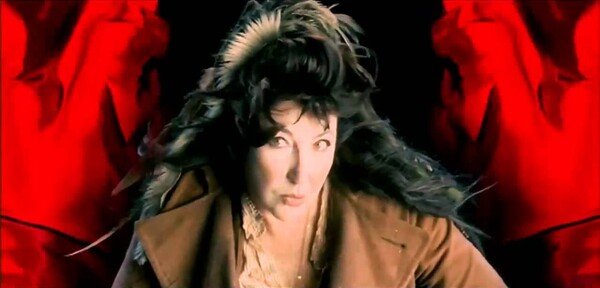
The music video for “King of the Mountain,” the lead single from Kate Bush’s 2005 album “Aerial,” stands as a poignant exploration of fame, legacy, and the elusive nature of iconic figures. Unlike her earlier, more narrative-driven works, this video employs a more abstract and symbolic approach, weaving together visuals that hint at themes of memory, loss, and the cyclical nature of life and art.
“Deeper Understanding” (2011 Version)
Originally released on her 1989 album “The Sensual World,” “Deeper Understanding” received a visually updated treatment in 2011, accompanying the release of her album “Director’s Cut.” The song, prescient in its original form, discusses the growing dependency on technology and the internet, foretelling the isolation and alienation that can result from digital immersion. The updated video, directed by Bush herself, features Robbie Coltrane as a computer-addicted individual and Frances Barber as the voice of the computer, with Albert McIntosh, Bush’s son, appearing as the personification of the virtual world.
The Visuals of “50 Words for Snow”: Ethereal Narratives and Animated Poetry
Kate Bush’s 2011 album “50 Words for Snow” is a testament to her enduring innovation, not just musically but also visually. The album, characterized by its introspective themes and the exploration of snow’s transformative power, is complemented by a series of music videos that delve into animation and abstract storytelling, offering a visual counterpart to the album’s ethereal and contemplative nature.
“Wild Man” Animation
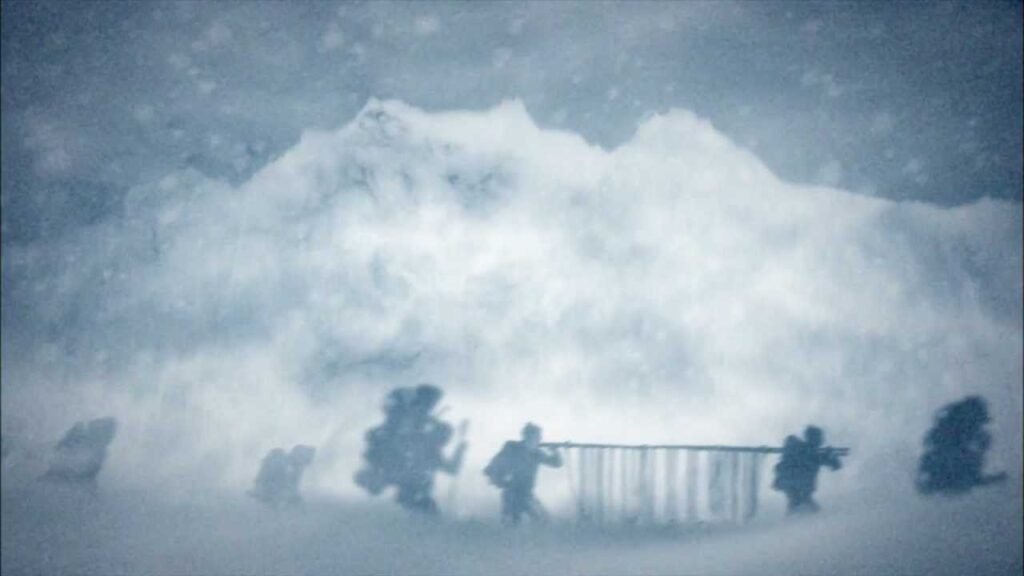
The “Wild Man” video takes viewers on a journey into the heart of the Himalayas, exploring the legend of the Yeti through animated storytelling. This animation, with its subdued palette and delicate illustrations, captures the song’s narrative about the mysterious and misunderstood creature, reflecting on humanity’s tendency to fear and mythologize the unknown. The video’s use of animation allows for a fluid, dreamlike storytelling that mirrors the song’s gentle yet poignant exploration of themes of discovery, empathy, and the preservation of mystery in the modern world.
“Mistraldespair”
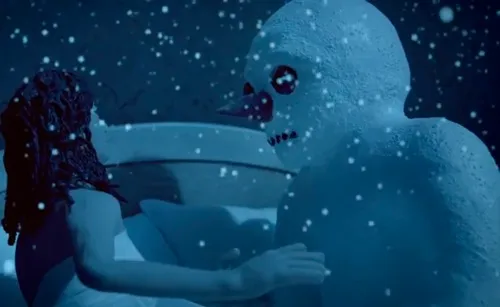
“Mistraldespair,” an abstract visual piece, accompanies the hauntingly beautiful track that delves into the themes of longing and the ephemeral nature of human connections. The video features minimalist visuals that depict a couple moving through a snowy landscape, their figures blurred and intertwined with the falling snow. This visual simplicity serves to highlight the song’s emotional depth, using the snow’s constant, gentle descent as a metaphor for sadness, loss, and the passing of time. The video’s pacing and imagery create a space for reflection, perfectly complementing the song’s meditative quality.
“Elder Falls at Lake Tahoe”
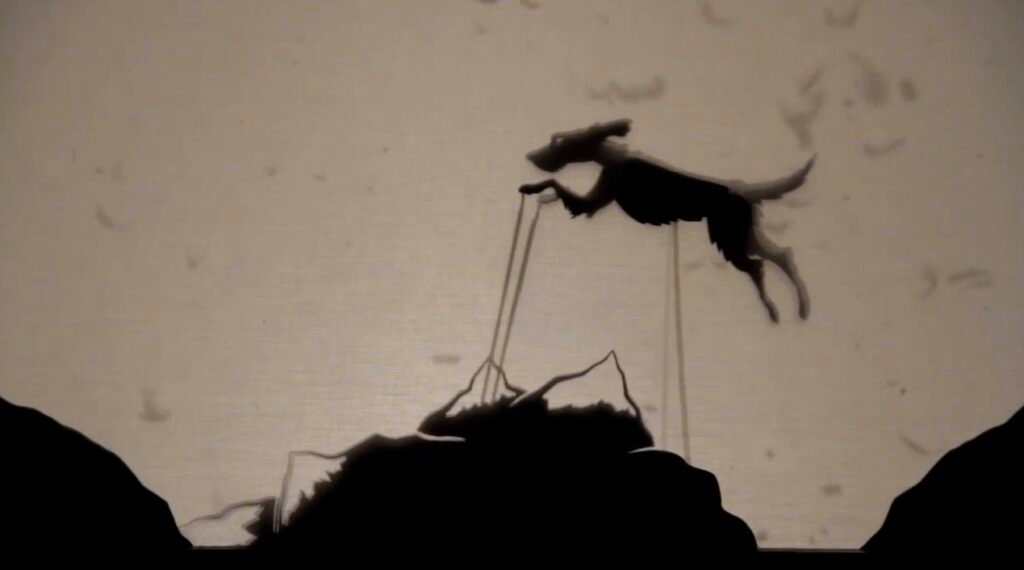
For “Elder Falls at Lake Tahoe,” Bush presents an even more ambitious narrative, telling the story of an elderly woman’s ethereal journey after falling into a frozen lake. This video combines haunting visuals with a storytelling approach that feels both mythical and deeply personal. Through a mix of live-action and animation, viewers are taken on a surreal journey beneath the ice, where the boundaries between life and death blur, reflecting on themes of memory, rebirth, and the mystical qualities of nature. The video’s beautiful, otherworldly landscapes and its poignant narrative encapsulate the album’s overarching themes of snow as a symbol of transformation and transcendence.
Conclusion: A Tapestry of Snow and Stories
The videos from “50 Words for Snow” are integral to the album’s exploration of the various manifestations of snow, both as a physical phenomenon and a symbolic element. Through the use of animation and abstract visuals, Kate Bush extends her musical storytelling into the visual domain, creating pieces that are not merely accompaniments to her songs but are standalone works of art. These videos highlight her ability to innovate and adapt, utilizing contemporary visual techniques to enhance her thematic explorations. In doing so, Bush continues to push the boundaries of what can be achieved in the realm of music video artistry, proving once again her status as a visionary artist whose work transcends the ordinary, inviting listeners and viewers alike into her unique world of imagination and depth.
